About Favignana
Favignana is the largest and most important of the Egadi Islands, three islands off the western coast of Sicily (the other two islands are Levanzo and Marettimo). Favignana has good, frequent ferry connections with the other islands and with Trapani; the proximity of Trapani Airport makes the island remarkably accessible from the rest of Europe. This easy access hasn’t – yet – spoiled the island, which is a fairly low-key destination most visited by Italian holiday-makers. Although there are tourist amenities, the island’s character seems little-altered, and travellers who come here are happy to fit in with the leisurely island way of life. One of the charms of the Egadi Islands is that they have never been populated with villas of the rich, nor frequented by the showy, and no out-of-character attractions have been developed for tourists, so compared with the crowded tourist islands of Capri and Ischia, and the chic atmosphere of some of the Aeolian Islands, Favignana and its Egadi siblings have a refreshing simple authenticity.
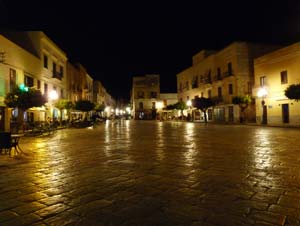
Favignana’s shape is often fancifully compared to a butterfly; it is composed of two flat stretches of land on either side of a high rocky spine, topped by a decaying fortress. Ferries arrive at Favignana town, the only substantial settlement on the island. The town is situated on the eastern side of the island, which is connected to the western side by a road-tunnel through the hill which divides the two plains.
Favignana town is a cheerful place, with a real local atmosphere and a friendly attitude to the tourists who arrive. The centre of town is pedestrianised for the evening passeggiata. In the main squares, Piazza Madrice and Piazza Europa, old men sit outside cafes passing the time of day, and children play on their bicyles while their parents do the shopping or stop for a chat.
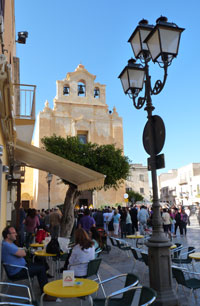
Favignana belonged to a family from Genoa for a couple of centuries, until it was purchased by the entrepeneurial Sicilian Florio family in the nineteenth century. The grandest house in town, and the tuna fishery across the harbour, were both built by the Florios, who ran a successful tuna-fishing business on Favignana. Tuna-fishing is still important here; Favignana has one of the very few traditional tuna fisheries (tonnare) still operating in Sicily. Each year in May or June, when tuna fish migrate in large numbers past the islands, the fishermen entrap them in a sequence of nets culminating in the ‘Chamber of Death’ where the fish are pulled to surface and bludgeoned to death in a gory spectacle called the mattanza. The mattanza has its own historic rituals, including working songs, and it is controlled by a leader, often hereditary, called the rais, who is the holder of generations of tuna wisdom and superintends the timing and operation of the fishing. Nowadays the mattanza is a tourist attraction, which can be viewed by visitors and which features in bloody postcards.
Ever since the Roman era, Italians have used their offshore islands as prisons, and Favignana still fulfils this function. A prison, built on and around the site of a Norman castle, sits close to the centre of Favignana town.
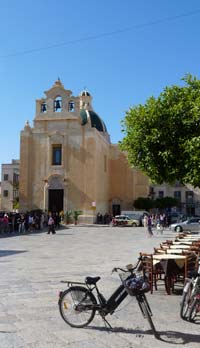
Things to do
Favignana is a great place to absorb the island atmosphere and stroll around the little town. As well as interesting shops, some touristy and some foody, there are fishermen selling their fresh catch from stalls and the back of ape trucks, boats bobbing in the harbour and a stretch of sand along the back of the bay. (For more on beaches and swimming, see below). The island’s tuna-fishing heritage is frequently visible, from the tuna products in shops to the town’s grandest buildings, the tuna fisheries. The large complex of the Stabilimento Florio, over the harbour from the centre of town, has been over-zealously restored thanks to EU funds, and now hosts a cultural and conference centre; there is talk of a local museum within the development, so check if it’s open when you visit.
The Egadi islands are intimately connected with the sea which surrounds them, and touring by boat is an obvious and attractive option. It’s possible to hire your own boat, or to take part in an excursion. At weekends and in the summer you are likely to be propositioned by boatmen around the harbour, offering trips around the island or to beaches. Otherwise, ask at your hotel or one of the offices in town advertising boat excursions. Scuba-diving and snorkelling are popular activities around all of the Egadi Islands; the clear, clean waters are protected by a marine reserve. There are diving centres in Favignana town which organise excursions and lessons. If you are keen on fishing, or are interested in local traditions, you could consider joining a fisherman on a fishing trip – look out for signs advertising pescaturismo.
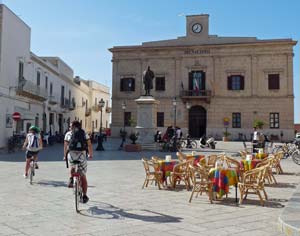
Favignana’s flat landscape and scarcity of traffic make the island an ideal place to go cycling. There are many competing shops at the port and in town offering bicycle rental (noleggio bici) at cheap prices – when we visited, before the peak summer season, we paid just 2 per day for bike hire. You should take a passport or similar document as a guarantee. Get hold of a simple map, or follow the coastline, and you can sail along empty roads, and bump along scenic tracks to discover the remoter parts of the island and reach secluded coves. Within the eastern half of the island, within half a day you can visit dramatic tufa quarries, several beaches and rocky coves, the bizarre excavated landscape caused by tufa quarrying and a picturesque fishermen’s hamlet. It’s also possible to join guided tours by bike.

Favignana’s tufa quarries are remarkable feature of the island. Some – such as the one which can be visited on the north-eastern coast (see my map of the islands) – are caverns with vast, cathedral-like interiors. Others consist simply of pits where short-term cottage industry has eaten away the surface of the island – in some places the road and a house are left standing alone with the land around them all dug away to a depth of several metres. Some of these subterranean spaces are now cultivated and used for gardens or allotments; with their stone columns and stairways these are truly bizarre and memorable sights. One such garden, the Giardino dell’Impossibile, is open to the public, and can be toured by appointment.
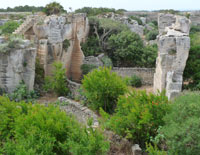
The distances on Favignana are small enough that walking is a possible way of seeing the island, though a bicycle is definitely more fun and more efficient on the long, flat stretches of road. The best walking excursion from Favignana town – and the most obvious – is up to the castle dominating the island’s hill. The route is straightforward – past the beach and out along a straight road from town, then zig-zagging up a paved stepped path. It is quite a climb, but nevertheless a popular outing in the late afternoon, once the heat of the day has passed. The castle, called the Forte di Santa Caterina, is officially closed to the public, but when I visited it was easy to enter the decrepit building and expore its extensive interior and terraces, all crumbling away in a state of abandonment. Dating from Norman times, and extended under the Spanish in the seventeenth century, the fortress is in a breathtaking location. The views from up here, on the ridge separating the island’s two halves, are worth the walk alone.

Getting around Favignana
If you don’t fancy cycling or walking, it is possible to hire other vehicles such as scooters, open-top buggies and cars at rental offices by the port. The island also has a bus service, with three routes which enable you to reach most parts of Favignana, though the buses don’t run often and you’ll need to fit around their timetables.
An entertaining alternative way of touring the island in summer is to take the trenino a little tourist ‘train’ which trundles around the island’s roads. Leaving from the port, the train has different routes, including a long circuit which visits the western half of the island. A more staid option is to take a taxi or mini-bus tour around Favignana; you’ll see adverts for these around town.
Beaches
Favignana has several small beaches, some of which, though popular, are fairly hard of access. One of the most sought-after bathing spots is Cala Rossa, a pretty bay with turquoise sea. Visitors turn up on bicyles, scooters or in boats to drape themselves over rocks, or wade out from the pocket-handkerchief sized sandy beach. It’s quite a scramble to get down the rocks onto the beach, but determined holiday-makers don’t let this deter them. A much more comfortable beach experience can be enjoyed at Lido Burrone, a wider sandy beach where there is a bar, a restaurant, and facilities including sun-beds and parasols for rent.
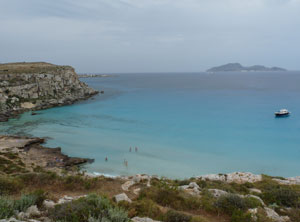
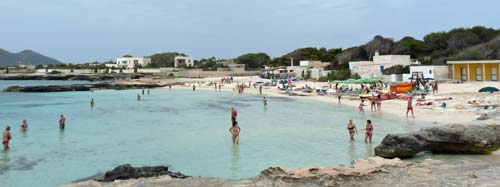
Shops, restaurants and services
Favignana is sleepy at times, but the town is the centre of the island community and after the afternoon siesta it comes to life. A good range of food shops open their doors, from a fishmonger, selling tuna with today’s price scrawled on a paper notice, to souvenir food shops for tourists selling all kinds of local specialities (frequently tuna). One of the best places to buy a good, cheap meal on the go is a little bakery uphill from Piazza Madrice which sells small take-away pizzas for bargain prices, as well as the ubiquitous Sicilian pastries. For a sit-down restaurant meal there is quite a good choice in Favignana, and prices are reasonable, considering the island location. Amici del Mare, by the waterfront on Piazza Marina, serves fresh seafood prepared in the cavernous interior – a tuna fish chopped up as required was the star attraction when we ate there – with rather rushed staff but a good atmosphere.

Travel to Favignana
Favignana is the principal island of the Egadi archipelago and it is well-connected with the other islands and with Sicily, with many daily services to Trapani and several ferries to Marsala. By hydrofoil Favignana is only thirty minutes or less from Trapani (the island of Levanzo is frequently an intermediate stop).
Accommodation
Favignana has a good choice of accommodation, from hotels to holiday apartments. One of the best places to stay on the island is the very central, stylish I Pretti Resort. We stayed in the Hotel Il Portico, close to both ferries and the main town piazza, a comfortable and good place to stay.
> More accommodation on the Egadi Islands

On this site
Useful external links
Egadilandia – mini train
Giardino dell’Impossibile – tufa quarry garden – book ahead
